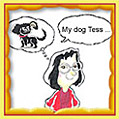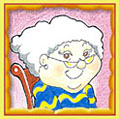Text types: Particular Descriptions
| Describing people and things |
Describing people and things using noun groups
In particular descriptions noun groups are used to describe a topic. Here are some noun groups used to describe the topics in the sample particular descriptions. These noun groups answer the question What is the character like?:
|
|
 |
|
|||||||||||||||||

|

|

|
|||||||||||||||
When a noun group is used to describe the topic, the Thing ![]() tells us what
aspect of the topic is being described and one or more Describers
tells us what
aspect of the topic is being described and one or more Describers
![]() tell us what this Thing is like:
tell us what this Thing is like:
|
noun group |
|
|
what like?
Describer |
what? Thing |
| big, brown | wings |
When there is more than one Describer, we usually put a comma between them. We
describe size first and colour last:
|
noun group |
|||
|
what like?
|
what?
Thing |
||
| size |
colour |
||
| long, | soft, silky, | black | hair |
| big, | brown | wings | |
| sparkling | brown | eyes | |
If we describe our opinion of the topic, the opinion Describer usually goes
before all the other Describers. Here is a noun group which includes an opinion of
Tess:
 |
|
||||||||||||||||||
Sometimes we add an Intensifier ![]() to an adjective in a noun group. In the
example below the opinion adjective is intensified:
to an adjective in a noun group. In the
example below the opinion adjective is intensified:
| noun group | ||||
| which?
Pointer |
what like? |
what?
Thing |
||
| intensifier + opinion | size | colour | ||
| a |
very cute |
little, | black | nose |
If we classify the Thing (ie say what type it is) the
Classifier ![]() is placed last, immediately in front of the Thing.
Here is a noun group which classifies the
dog Tess and answers the question, What type?:
is placed last, immediately in front of the Thing.
Here is a noun group which classifies the
dog Tess and answers the question, What type?:
|
|
 |
| noun group | ||||
| which? Pointer |
what like?
|
what
type? Classifier |
what?
|
|
| size | colour | |||
|
a |
small, | black | long-haired | lapdog |
Sometimes we add more describing information after the noun in a Qualifier
![]() :
:
| noun group | |||
|
which? |
what like?
|
what? |
more
information |
| a |
small, black, long-haired |
lapdog |
with one white paw |
| a | bat |
in a story |
|
|
the |
oldest |
person |
in the Gong family |
Sometimes we add two noun groups together to make a noun group complex. We
usually join the noun groups with the conjunction and:
| noun group 1 |
+ |
noun group 2 |
|
a cute little black nose |
and |
soft floppy ears |
| long soft silky black hair |
and |
dainty paws |
Sometimes a noun group complex has more than two noun groups. There is a
comma after each noun group except the second last one. The conjunction and
is used to add the last noun group:
| noun group 1 |
+ |
noun group 2 |
+ |
noun group 3 |
+ |
last noun group |
| grey fur | , | pointy ears | , | big round eyes | and | a black shiny nose |
Noun groups in particular descriptions often begin with a determiner ![]() or pointer. The most common determiner is the article
or pointer. The most common determiner is the article ![]() . A noun group built around a singular noun can begin with an indefinite
article (a/an). A noun group built around a plural noun,
however, does not
usually use a pointer at all except to indicate
quantity.
. A noun group built around a singular noun can begin with an indefinite
article (a/an). A noun group built around a plural noun,
however, does not
usually use a pointer at all except to indicate
quantity. ![]()
When a noun group uses the definite article the, we know the noun
group is referring to a particular person, place or thing. Sometimes we know the particular person, place or thing because it is
something everyone knows about. For example, when we say the
Peak in Hong
Kong, everyone knows which particular mountain peak we are talking about. We
also use the definite article the when we have introduced the person, place or thing
somewhere else in the text. ![]()
Another use of the definite article the is when we say someone or something is the most of anything (eg the best, the biggest):
|
which? |
what like?
|
what? Thing (singular) |
more information |
| the | oldest | person |
in the Gong family. |
Countable nouns ![]() are either singular or
plural, while uncountable
nouns
are either singular or
plural, while uncountable
nouns ![]() are neither singular nor plural. Sometimes, when we build a noun group
around an uncountable noun, we describe the quantity or a container for the
uncountable noun.
are neither singular nor plural. Sometimes, when we build a noun group
around an uncountable noun, we describe the quantity or a container for the
uncountable noun. ![]()
| To see how noun groups are used to
describe in the particular description My dog Tess, click
here: |
 |
| To see how noun groups are used to
describe in the particular description Boris the Bat, click
here: |
 |
| To see how noun groups are used to
describe in the particular description Granny Gong, click
here: |
 |
| To see how noun groups are used to
describe in the particular description The Gong family flat,
click here: |

|
For more information about noun groups, see ![]() Grammar: Groups & phrases: Noun
group: Overview
Grammar: Groups & phrases: Noun
group: Overview
|
Tell me more ... Focus on Grammar |
|
||
To give us feedback about this section, click here or on the Comment button at the top of the screen.
If you have any questions about this section, visit the Language Corner.
If you have any questions or suggestions about how to teach this section, send a message to the Teaching Corner.